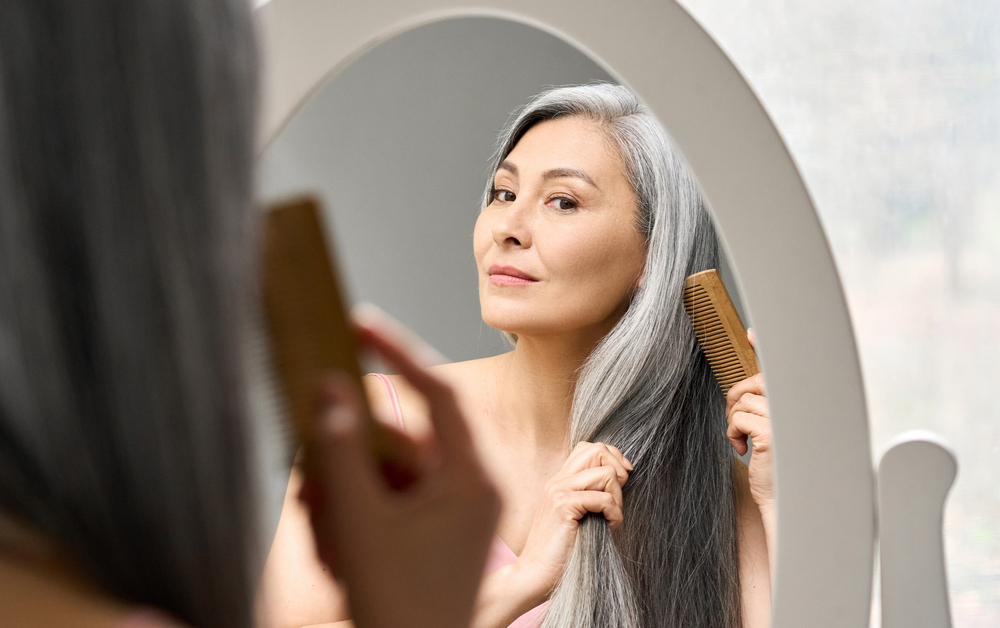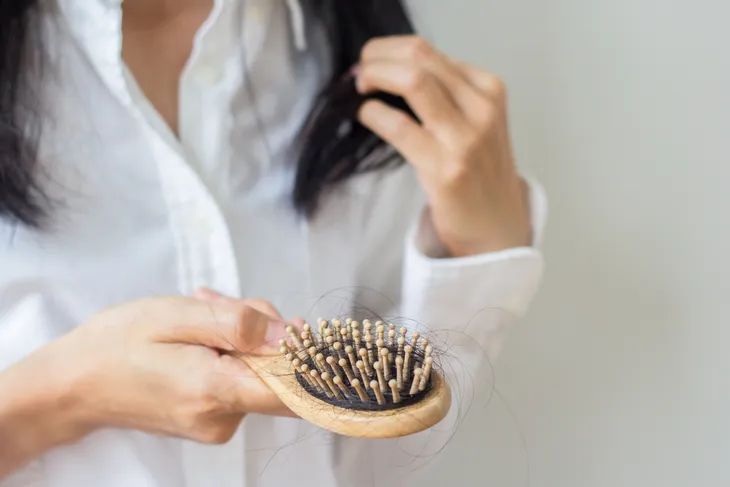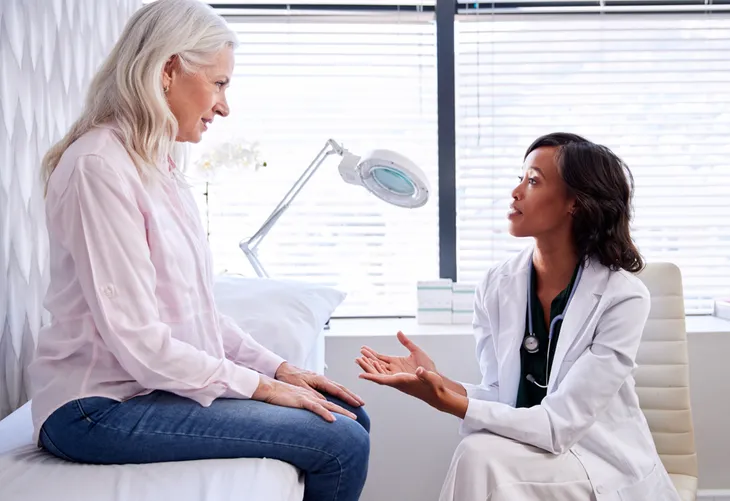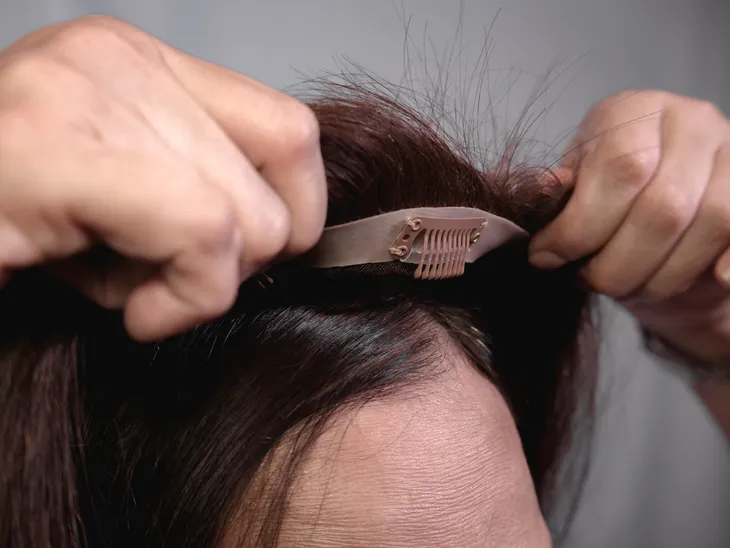- Most people associate hair loss with men but the fact is, it’s quite common in women too.
- Female pattern baldness is often genetic but it can also be caused by underlying health problems.
- Some hair loss can be temporary but without treatment, female pattern baldness is permanent. Luckily there are treatment options available.
Just like the rest of our body, it’s normal to notice changes to our hair as we age. While many people believe hair loss only happens to men, it’s actually quite common in women too. In fact, the Cleveland Clinic says that more than 50-percent of women will experience noticeable hair loss in their lifetime.
It’s normal to shed up to 100 hairs each day but new growth usually replaces these hairs, which doesn’t make the loss noticeable. However, women who have female pattern baldness will lose the same hair but it won’t grow back. So, how do you know if you’re experiencing female pattern baldness and what can you do about it? We’ll answer that and more in this article!
What Is Female Pattern Baldness?
Female pattern baldness, also called androgenetic alopecia, is a type of hair loss that affects women. Medical News Today says that though hair loss is less frequent in women than men, it’s still quite common. The source explains, “Female pattern baldness increases with age, and fewer than 50 percent of women have a full head of hair for their entire life.”
It’s also similar to male pattern baldness but it develops in a different pattern. For example, men tend to develop a receding hairline and bald spots whereas women with female pattern baldness usually develop general thinning of the hair. It’s also common for the thinning to be most noticeable in the middle part, causing a widening of the part.
Signs of Female Pattern Baldness
So, how do you know if you’re experiencing female pattern baldness? The Cleveland Clinic says some of the first signs may be noticeable hair that falls out. If you notice more hair than usual on your brush, on the floor or on your pillow, or in the shower, then this may be a key indicator you’re experiencing hair loss.
The Icahn School of Medicine at Mount Sinai also points out that female pattern baldness often starts at the center hair part, so if you notice a widening part or thinning at the crown of the scalp, then this can also indicate female pattern baldness. A general thinning of the hair can also be a sign of female pattern baldness.
Types of Female Pattern Baldness
According to Healthline, doctors often categorize female pattern baldness into three types. For starters, type 1 means there is a small amount of thinning, usually beginning at the middle part.
Type 2 female pattern baldness is categorized by a widening of the part, as well as increased thinning around it. And finally, type 3 refers to female pattern baldness that is thinning throughout, “with a see-through area at the top of the scalp,” explains the source.
What Causes Female Pattern Baldness?
Female pattern baldness is often caused by genetics. This means it does run in families. Medical News Today says that women can inherit the gene from either parent.
The source also notes that hormonal changes that occur during menopause can also be a contributing factor. Female pattern baldness also tends to be more common once a woman reaches midlife, however, it can still start earlier.
Other Possible Causes
While genetics is the most common cause, it can also be caused by a variety of other factors. For starters, Medical News Today notes that an underlying condition that affects your production of the hormone androgen may increase your risk for female pattern baldness.
Having an autoimmune disease like alopecia areata can also lead to hair loss. Traction alopecia which is a condition that causes hair loss when you wear your hair in styles that pull the strands too tightly can also lead to hair loss. Finally, the source also notes that certain medications and illnesses can also cause female pattern baldness.
Who’s At Risk for Hair Loss?
Any woman can experience hair loss but some women may be more susceptible than others. For starters, the Cleveland Clinic says age plays a factor as hair loss is more common in women over 40.
Menopausal women also have an increased risk of hair loss. In contrast, the source notes that women who just gave birth are also at risk for hair loss. Some medications, such as chemotherapy, can also increase your risk. As can certain hairstyles or using harsh chemicals on your hair.
 Shutterstock/Olena Yakobchuk
Shutterstock/Olena YakobchukWhen to See a Doctor
Sometimes hair loss can be a sign of an underlying medical condition or a side effect of medication, so you should always see your doctor if you suddenly notice hair loss. Continuous hair loss also warrants a doctor’s visit.
The Icahn School of Medicine at Mount Sinai also notes that you should also see a doctor if your hair loss is accompanied by itching, skin irritation, or other abnormal symptoms. A medical evaluation is important to help rule out any serious medical conditions.
Diagnosing Hair Loss in Women
Hair loss is typically diagnosed by a doctor or dermatologist. Healthline points out that testing isn’t usually necessary but the medical professional will examine your scalp and look for the pattern of hair loss.
If your doctor suspects female pattern baldness is not the cause for your hair loss, they may request blood tests to check for thyroid disease or an iron deficiency, both of which can contribute to hair loss. They may also look for signs of too much male hormone (androgen). In some cases, a skin biopsy of the scalp may be necessary to diagnose a skin disorder that causes hair loss.
How Is Female Pattern Baldness Treated?
Some hair loss can be temporary but without treatment, female pattern baldness is permanent. However, it’s important to point out, many cases are mild to moderate so if you’re comfortable with your appearance you don’t need treatment. But if you’re not comfortable, you do have options.
For starters, there are medications that may improve hair growth. Some medications are applied topically to the scalp to encourage hair growth but it is a long-term solution. This means you’ll have to use it for a long time, otherwise, hair loss will start again after using it and the new hair growth will fall out. You’ll need to talk to your doctor to find out which medication is best for you and to weigh the pros and cons of taking it. There are also other possible treatment options which we’ll dive into next!
Hair Transplant
If you don’t respond well to medical treatment another option you can consider is a hair transplant. Medical News Today explains that during a hair transplant, a doctor “removes hair from an area with healthy hair growth and transplants it to another spot where the hair is missing.”
The source says patients are awake during the procedure but are given a local anesthetic. You can expect a hair transplant to take several hours. The biggest benefit of a hair transplant is that the results are often great and permanent, however, it can be expensive.
Laser Treatment
While a hair transplant can be an effective and permanent solution for female pattern baldness, it is the most invasive treatment option. A less invasive option you can consider is laser treatment. Healthline explains that low-level laser therapy (also known as red light therapy or cold laser therapy) can help encourage hair growth by invigorating circulation and stimulating the hair follicles.
Keep in mind, the results of laser therapy for hair loss are inconsistent, meaning it works for some people and not for others. But one study found that it’s safe and effective for both men and women to try. While it is noninvasive and painless, and there are no known side effects, it can be time-consuming and expensive, plus it doesn’t work for everyone. It’s important to weigh the pros and cons with a dermatologist to find out if you should try laser treatment.
Other Possible Solutions
If your hair loss is minor, you may be able to hide it by embracing a new hairstyle. Another possible solution is investing in a hairpiece that can help hide hair loss.
Both of these options are far less expensive compared to other treatment options. While they don’t provide hair growth, they can improve your appearance which may provide the confidence you need. Book an appointment with your hair stylist to discuss these options to find out which is best for you.
Can Female Pattern Baldness Be Prevented?
Since female pattern baldness is often genetic, it can’t always be prevented. That said, there are things you can do to keep your hair as healthy as possible, which can help prevent damage and breakage.
For starters, avoid tight hairstyles as much as possible and be cautious of damaging chemicals like perming and bleaching your hair. Even applying too much heat from hair dryers, straighteners and curling irons can cause damage to your hair.
Medical News Today also suggests eating a diet rich in protein, iron, and other essential vitamins to encourage strong, healthy hair. Protecting your hair from the sun by wearing a hat and avoiding brushing your hair when it’s wet and fragile can also help prevent damage.















